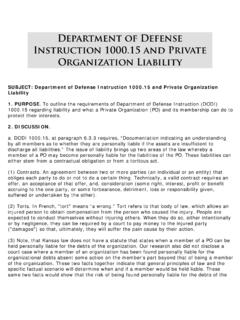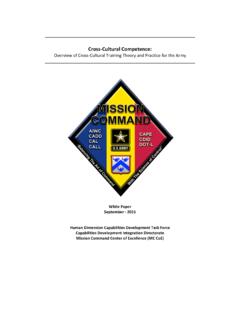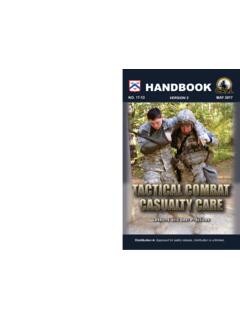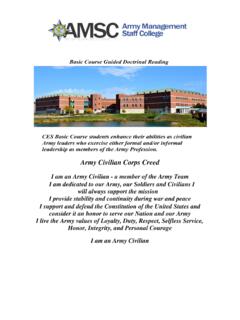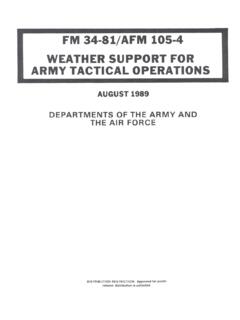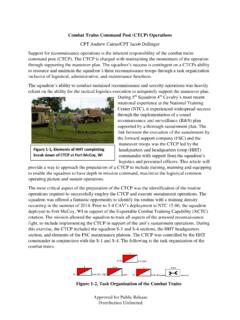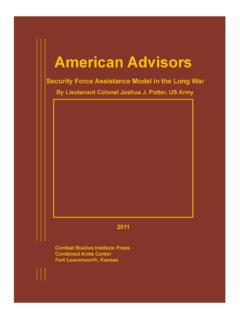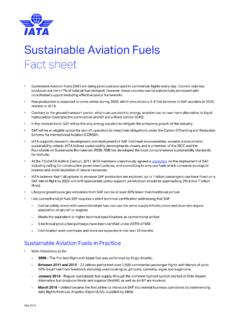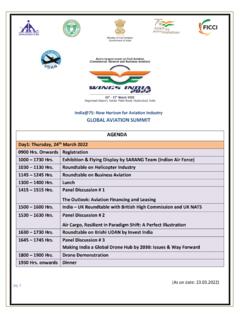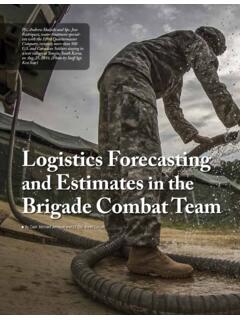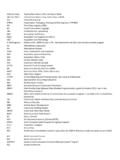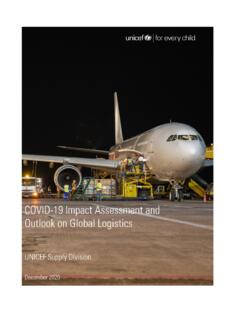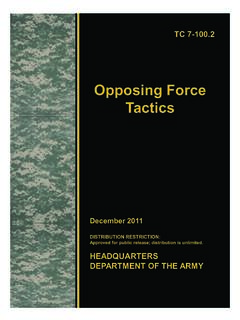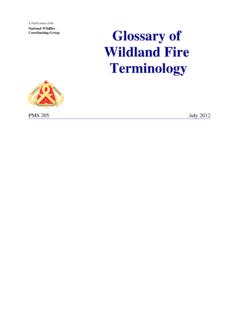Transcription of Handbook: Special Operations Joint Task Force
1 United States Army Special Operations Command Capability Developments Integration Directorate Handbook: Special Operations Joint Task Force Version 27 September 2019 Approved for Public ReleaseDistribution Unlimited i Contents Contents .. i Executive Summary .. iv Section 1: Employment Guide for the Special Operations Joint Task Force in Large Scale Combat Operations .. 5 Purpose .. 5 Context .. 5 The SOJTF .. 5 The SOJTF in Large Scale Combat Operations .. 7 Multi-Domain Operations .. 7 In the Deep Fight .. 7 In the Close Fight .. 8 Consolidating Gains .. 8 SOJTF Relationship to the Joint Functions .. 9 Command and Control .. 9 Intelligence .. 9 10 Movement and Maneuver .. 10 Protection.
2 10 Sustainment .. 11 Information .. 11 Other Considerations .. 11 The SOF, Cyberspace, and Space Nexus .. 11 Unity of 12 CF-SOF Operational Synergy .. 13 Experimentation .. 14 Conclusion of Section 1 .. 14 Section 2: Special Operations Joint Task Force in Large Scale Combat Operations Mission Command Handbook .. 15 Why This Handbook? .. 15 What is SOFs Value Proposition for LSCO? .. 15 How Does SOF Help to Shape the Deep Fight? .. 16 How Does the SOF, Cyber and Space Nexus Contribute to LSCO? .. 16 What are Some Key SOF Limitations You Should Ensure the Conventional Force Commander and Staff Understand? .. 17 ii What are Some Important Task Organization Considerations? .. 17 Some Considerations and Benefits of Cross-functional Organization.
3 17 Setting a Battle Rhythm to Safeguard the Commander s Most Precious Asset Time! .. 19 Remember to Include Interorganizational Partners and Allies.. 20 Always Maintain Operational Balance and Stance .. 22 How Do You Develop an Operational Framework? .. 22 Intelligence Preparation is Vital to Successful Operations .. 22 Event Templates (EVENTTEMP) are a Proven Means to Guide the Best Use of Collection Assets .. 24 Predictive Assessments are Difficult to Execute, but are Necessary .. 25 Developing an Operational Approach Requires Understanding the OE and Input from Assessments .. 26 Defining the Challenges is Key to Understanding the Operational Environment .. 27 How do You Develop Shared Understanding?
4 28 Recognize that Shared Understanding is a Vital Component of Mission Command .. 28 Recognize the Relationship Between Information Sharing and Operational Success .. 29 Always Consider Interorganizational Factors .. 29 How do the Operations Process and Assessment Interact? .. 30 The Start Point is the Commander s Visualization .. 30 The Operations Process Depends on a Number of Other Processes .. 32 Planning Horizons Scope the Operational Approach .. 36 SOJTF Operations Take Place Throughout the Operational Area .. 36 Coordinating Deep Operations .. 38 How Does the Joint Effects Targeting Process Integrate With the Joint Planning Process? .. 39 Targeting is an Extension of Planning.
5 39 SOF Employs an Integrated and Joint Approach to Targeting .. 42 Joint Force Air Component Commander (JFACC) Considerations and the Air Tasking Order (ATO) Process Constrain SOJTF Operations .. 42 The SOJTF Integrates Non-Lethal and Lethal Effects From the Start of Planning .. 42 Non-Lethal and Lethal Effects Employ the Same Targeting Process .. 43 Non-Lethal Targeting Requires Non-Lethal Assessment Metrics .. 44 Lethal Assessment Metrics Have a Well Established Framework Battle Damage Assessment (BDA) .. 44 Does the SOJTF Need an Information Warfare Task Force (IWTF)?.. 45 The IWTF Addresses Challenges in the Information Environment .. 45 iii The Key to IWTF Success is Integration at All Levels.
6 46 The IWTF Develops Influence Plans .. 46 IWTF Operations Can Occur Throughout the Operational 47 How Does the SOJTF Achieve CF-SOF Interdependence, Interoperability, and Integration (I3)?.. 48 Understand Their Different Perspectives .. 48 Additional Considerations for SOF-CF Interoperability .. 48 Establish Authority Who is in Charge? .. 49 Consider Multinational Operations I3 .. 49 What is Necessary to Sustain SOF in LSCO? .. 50 Integration between SOF, CF, and Other Sustainment Sources is Paramount .. 50 Consider the Following in the Planning Process .. 51 Health Support Planning Considerations .. 52 Coordination between Joint Health Services Sources (HSS) is Paramount .. 54 Acronym List.
7 55 The USASOC Handbook: Special Operations Joint Task Force is approved for public release as of 16 October 2019. It will be reviewed in the fourth quarter of every fiscal year to ensure the content remains current and adaptive to emerging conditions in the operating environment. iv Executive Summary Organization: The Handbook for employing the Special Operations Joint Task Force (SOJTF) in Large Scale Combat Operations (LSCO) is organized into two sections. Section 1: Employment Guide for the Special Operations Joint Task Force . The purpose of this part of the handbook is to present the SOJTF as the Special Operations echelon most suitable to converge cross-domain effects in support of a Joint Force Commander during preparation of the operational environment during competition and in LSCO during conflict.
8 This document is not doctrinal but conceptual therefore, some of the capabilities envisioned by the authors may not be available at present. However, most, if not all, of the capabilities required for LSCO are currently under development and are expected to be operational by the year 2028. The Army and Joint Special Operations communities are developing and testing the systems, structures, and skills that will allow for converging multi-domain effects, taking full advantage of SOF s unique abilities to see, sense, and strike deep. The SOJTF will be the organization of choice to converge SOF, Cyberspace, Space, Intelligence, and Fires to generate the effects that open windows of opportunity for Joint Force maneuver.
9 Section 2: The SOJTF Mission Command Handbook. Section 2 addresses SOJTF operational level mission command during LSCO. The primary purpose of this section is to describe the processes and staff functions that support the SOJTF Commander s decision cycle. The principal users are SOJTF staff officers, non-commissioned officers, and civilian personnel who develop SOJTF campaign plans, concepts of operation, and design operational level exercises and training programs to prepare for and execute Special Operations in LSCO. Section 2 describes various tactics, techniques, and procedures (TTP) to assist the SOJTF staff in shaping the deep fight for the Joint Force through a combination of core SOF activities: Direct Action (DA), Special Reconnaissance (SR), Countering Weapons of Mass Destruction (CWMD), Counterterrorism (CT), Unconventional Warfare (UW), Foreign Internal Defense (FID), Security Force Assistance (SFA), Hostage Rescue and Recovery (HRR), Counterinsurgency (COIN), Foreign Humanitarian Assistance (FHA), Preparation of the Environment (PE), Military Information Support Operations (MISO) and Civil Affairs Operations (CAO).
10 Way Ahead: The United States Army Special Operations Command (USASOC) will distribute this document to the appropriate organizations for continued development through wargaming, experimentation, and operational application. Lessons learned will be collected, analyzed, and incorporated into subsequent versions of the handbook. USASOC expects to introduce this handbook into the formal Army and Joint doctrinal development processes in coordination with the United States Army John F. Kennedy Special Warfare Center and School. Conclusion: This handbook consists of two parts for use by two distinct audiences. Section one, the SOJTF Employment Guide is an up and out strategic communication for use by senior leaders and staff members who will find it useful when incorporating a SOJTF into campaign plans and contingency Operations that involve large scale combat.
